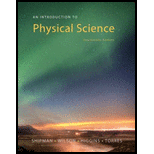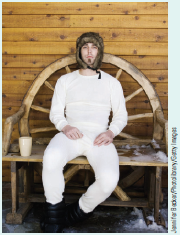
An Introduction to Physical Science
14th Edition
ISBN: 9781305079120
Author: James Shipman, Jerry D. Wilson, Charles A. Higgins, Omar Torres
Publisher: Brooks Cole
expand_more
expand_more
format_list_bulleted
Textbook Question
Chapter 5, Problem 16SA
Thermal underwear is made to fit loosely. (● Fig. 5.23). What is the purpose of this?

Figure 5.23 Make Them Loose-Fitting See Short Answer Question 16.
Expert Solution & Answer
Trending nowThis is a popular solution!

Students have asked these similar questions
Consider a rubber rod that has been rubbed with fur to give the rod a net negative charge, and a glass rod that has been rubbed with silk to give it a net positive charge. After being charged by contact by the fur and silk...?
a. Both rods have less mass
b. the rubber rod has more mass and the glass rod has less mass
c. both rods have more mass
d. the masses of both rods are unchanged
e. the rubber rod has less mass and the glass rod has mroe mass
8) 9)
10)
11)
12)
13)
14)
15)
Chapter 5 Solutions
An Introduction to Physical Science
Ch. 5.1 - We talk about temperature, but what does it...Ch. 5.1 - Are there any limits on the lowest and highest...Ch. 5.1 - Show that a temperature of 40 is the same on both...Ch. 5.2 - Prob. 1PQCh. 5.2 - Most substances contract with decreasing...Ch. 5.3 - What is specific about specific heat?Ch. 5.3 - Prob. 2PQCh. 5.3 - Prob. 5.2CECh. 5.3 - How much heat must be removed from 0.20 kg of...Ch. 5.4 - What are the three methods of heat transfer?
Ch. 5.4 - Prob. 2PQCh. 5.5 - Prob. 1PQCh. 5.5 - Prob. 2PQCh. 5.6 - In the ideal gas law, pressure is directly...Ch. 5.6 - Prob. 2PQCh. 5.6 - Prob. 5.4CECh. 5.7 - Prob. 1PQCh. 5.7 - Prob. 2PQCh. 5 - Prob. AMCh. 5 - Prob. BMCh. 5 - Prob. CMCh. 5 - Prob. DMCh. 5 - Prob. EMCh. 5 - Prob. FMCh. 5 - Prob. GMCh. 5 - Prob. HMCh. 5 - Prob. IMCh. 5 - Prob. JMCh. 5 - Prob. KMCh. 5 - Prob. LMCh. 5 - Prob. MMCh. 5 - Prob. NMCh. 5 - Prob. OMCh. 5 - Prob. PMCh. 5 - Prob. QMCh. 5 - Prob. RMCh. 5 - Prob. SMCh. 5 - Prob. TMCh. 5 - Prob. UMCh. 5 - Prob. VMCh. 5 - Prob. WMCh. 5 - Prob. XMCh. 5 - Prob. YMCh. 5 - Prob. 1MCCh. 5 - Which unit of the following is smaller? (5.2) (a)...Ch. 5 - Prob. 3MCCh. 5 - Prob. 4MCCh. 5 - Prob. 5MCCh. 5 - Prob. 6MCCh. 5 - Prob. 7MCCh. 5 - Which of the following has a definite volume but...Ch. 5 - If the average kinetic energy of the molecules in...Ch. 5 - When we use the ideal gas law, the temperature...Ch. 5 - Prob. 11MCCh. 5 - Prob. 12MCCh. 5 - When a bimetallic strip is heated, it bends away...Ch. 5 - Prob. 2FIBCh. 5 - Prob. 3FIBCh. 5 - Prob. 4FIBCh. 5 - Prob. 5FIBCh. 5 - Prob. 6FIBCh. 5 - Prob. 7FIBCh. 5 - The ___ phase of matter has no definite shape, and...Ch. 5 - Prob. 9FIBCh. 5 - In the ideal gas law, pressure is ___ proportional...Ch. 5 - Prob. 11FIBCh. 5 - Prob. 12FIBCh. 5 - When the temperature changes during the day, which...Ch. 5 - Prob. 2SACh. 5 - The two common liquids used in liquid-in-glass...Ch. 5 - An older type of thermostat used in furnace and...Ch. 5 - Heat may be thought of as the middleman of energy....Ch. 5 - When one drinking glass is stuck inside another,...Ch. 5 - Prob. 7SACh. 5 - What does the specific heat of a substance tell...Ch. 5 - When eating a piece of hot apple pie, you may find...Ch. 5 - Prob. 10SACh. 5 - When you exhale outdoors on a cold day, you can...Ch. 5 - Compare the SI units of specific heat and latent...Ch. 5 - Give two examples each of good thermal conductors...Ch. 5 - Prob. 14SACh. 5 - Prob. 15SACh. 5 - Thermal underwear is made to fit loosely. ( Fig....Ch. 5 - What determines the phase of a substance?Ch. 5 - Give descriptions of a solid, a liquid, and a gas...Ch. 5 - Prob. 19SACh. 5 - How does the kinetic theory describe a gas?Ch. 5 - Prob. 21SACh. 5 - Prob. 22SACh. 5 - Prob. 23SACh. 5 - In terms of kinetic theory, explain why a...Ch. 5 - Prob. 25SACh. 5 - Prob. 26SACh. 5 - Prob. 27SACh. 5 - Prob. 28SACh. 5 - What can be said about the total entropy of the...Ch. 5 - Prob. 30SACh. 5 - Prob. 31SACh. 5 - Prob. 1VCCh. 5 - Prob. 1AYKCh. 5 - Prob. 2AYKCh. 5 - Prob. 3AYKCh. 5 - Prob. 4AYKCh. 5 - Prob. 5AYKCh. 5 - Prob. 6AYKCh. 5 - When you freeze ice cubes in a tray, there is a...Ch. 5 - Prob. 8AYKCh. 5 - Prob. 1ECh. 5 - Prob. 2ECh. 5 - Prob. 3ECh. 5 - Prob. 4ECh. 5 - Researchers in the Antarctic measure the...Ch. 5 - Prob. 6ECh. 5 - A college student produces about 100 kcal of heat...Ch. 5 - Prob. 8ECh. 5 - A pound of body fat stores an amount of chemical...Ch. 5 - Prob. 10ECh. 5 - On a brisk walk, a person burns about 325 Cal/h....Ch. 5 - Prob. 12ECh. 5 - How much heat in kcal must be added to 0.50 kg of...Ch. 5 - Prob. 14ECh. 5 - (a) How much energy is necessary to heat 1.0 kg of...Ch. 5 - Equal amounts of heat are added to equal masses of...Ch. 5 - How much heat is necessary to change 500 g of ice...Ch. 5 - A quantity of steam (300 g) at 110C is condensed,...Ch. 5 - Prob. 19ECh. 5 - A fire breaks out and increases the Kelvin...Ch. 5 - A cylinder of gas is at room temperature (20C)....Ch. 5 - A cylinder of gas at room temperature has a...Ch. 5 - A quantity of gas in a piston cylinder has a...Ch. 5 - If the gas in Exercise 23 is initially at room...
Knowledge Booster
Learn more about
Need a deep-dive on the concept behind this application? Look no further. Learn more about this topic, physics and related others by exploring similar questions and additional content below.Similar questions
- Mick and Rick are twins born on Earth in the year 2175. Rick grows up to be an Earth-bound robotics technician while Mick becomes an intergalactic astronaut. Mick leaves the Earth on his first space mission in the year 2200 and travels, according to his clock, for 10 years at a speed of 0.75c. Unfortunately, at this point in his journey, the structure of his ship undergoes mechanical breakdown and the ship explodes. How old is Rick when his brother dies?arrow_forwardHi, I have canceled, why did you charge me again?arrow_forwardNo chatgpt pls will upvotearrow_forward
arrow_back_ios
SEE MORE QUESTIONS
arrow_forward_ios
Recommended textbooks for you
 Principles of Physics: A Calculus-Based TextPhysicsISBN:9781133104261Author:Raymond A. Serway, John W. JewettPublisher:Cengage Learning
Principles of Physics: A Calculus-Based TextPhysicsISBN:9781133104261Author:Raymond A. Serway, John W. JewettPublisher:Cengage Learning Physics for Scientists and Engineers with Modern ...PhysicsISBN:9781337553292Author:Raymond A. Serway, John W. JewettPublisher:Cengage Learning
Physics for Scientists and Engineers with Modern ...PhysicsISBN:9781337553292Author:Raymond A. Serway, John W. JewettPublisher:Cengage Learning College PhysicsPhysicsISBN:9781938168000Author:Paul Peter Urone, Roger HinrichsPublisher:OpenStax College
College PhysicsPhysicsISBN:9781938168000Author:Paul Peter Urone, Roger HinrichsPublisher:OpenStax College An Introduction to Physical SciencePhysicsISBN:9781305079137Author:James Shipman, Jerry D. Wilson, Charles A. Higgins, Omar TorresPublisher:Cengage Learning
An Introduction to Physical SciencePhysicsISBN:9781305079137Author:James Shipman, Jerry D. Wilson, Charles A. Higgins, Omar TorresPublisher:Cengage Learning College PhysicsPhysicsISBN:9781285737027Author:Raymond A. Serway, Chris VuillePublisher:Cengage Learning
College PhysicsPhysicsISBN:9781285737027Author:Raymond A. Serway, Chris VuillePublisher:Cengage Learning Physics for Scientists and Engineers, Technology ...PhysicsISBN:9781305116399Author:Raymond A. Serway, John W. JewettPublisher:Cengage Learning
Physics for Scientists and Engineers, Technology ...PhysicsISBN:9781305116399Author:Raymond A. Serway, John W. JewettPublisher:Cengage Learning

Principles of Physics: A Calculus-Based Text
Physics
ISBN:9781133104261
Author:Raymond A. Serway, John W. Jewett
Publisher:Cengage Learning

Physics for Scientists and Engineers with Modern ...
Physics
ISBN:9781337553292
Author:Raymond A. Serway, John W. Jewett
Publisher:Cengage Learning

College Physics
Physics
ISBN:9781938168000
Author:Paul Peter Urone, Roger Hinrichs
Publisher:OpenStax College

An Introduction to Physical Science
Physics
ISBN:9781305079137
Author:James Shipman, Jerry D. Wilson, Charles A. Higgins, Omar Torres
Publisher:Cengage Learning

College Physics
Physics
ISBN:9781285737027
Author:Raymond A. Serway, Chris Vuille
Publisher:Cengage Learning

Physics for Scientists and Engineers, Technology ...
Physics
ISBN:9781305116399
Author:Raymond A. Serway, John W. Jewett
Publisher:Cengage Learning
Thermal Expansion and Contraction of Solids, Liquids and Gases; Author: Knowledge Platform;https://www.youtube.com/watch?v=9UtfegG4DU8;License: Standard YouTube License, CC-BY